The Grenfell Tower disaster will define a generation. But could previous fires and inquiries have prevented it? SHP assesses the recent history of tower block fires.

The Grenfell Tower fire during the early hours of 14 June 2017.
Early on Wednesday morning, 14 June 2017, a fire from a faulty Hotpoint fridge-freezer began in an apartment on the fourth floor of the 24-storey Grenfell Tower in north Kensington, west London.
It is believed the fire then escaped from this flat through an open kitchen window, and spread onto combustible, non-fire retardant cladding – Reynobond PE, an aluminium composite material with a polyethylene core – before swiftly spreading across the exterior of the building.
By 1.30 am, approximately an hour after the original blaze in the flat, the fire had re-entered the building, with temperatures reaching 1000 degrees Celsius across well-ventilated communal areas, and as high as 800 degrees Celsius in enclosed flats. As dawn broke, the upper floors of the building were completely burnt out, and the majority of the structure was an inferno being tackled by 45 fire engines and hundreds of firefighters.
It would take several days before the fire was completely quelled, and during night-time news reports at the scene, small flames could be seen flickering in the blackened shell of the building. At the time of writing, the loss of life stands at 80 people – but some media outlets have claimed it could reach into the hundreds by the end of the recovery operation.

Grenfell debate at Firex 2017
The disaster at Grenfell Tower has caused much soul-searching in the fire and health and safety communities. It is a fair assumption to describe it as the defining event of this generation. The public inquiry will inevitably be a detailed and emotional affair, as shown by the intensity of discussion about the disaster at FIREX International 2017.
Deregulation
One of the key moments of the Protection and Management Series discussions on the fire was a clarion call to the government to re-assess its ‘bonfire of red tape’ – commonly referred to as the principle of a ‘one in, three out’ attitude to regulations. This government policy is actually a step-up from the previous coalition government’s ‘one in, two out’.
The Institution of Occupational Safety and Health (IOSH), Park Health and Safety, the Royal Society for the Prevention of Accidents (RoSPA), and the British Safety Council got together to sign an open letter for prime minister Theresa May, requesting an end to the deregulation of health and safety rules. It was signed by a further 70 organisations and individuals. Within two days it had amassed 700 signatories. In a sign of how the Grenfell Tower event has changed minds, even the Civil Engineering Contractors Association, which has previously campaigned for deregulation, has signed the letter.
The history
It is impossible to know the remit, width and depth of issues relating to the Grenfell public inquiry before the chair, Sir Martin Moor-Bick, has even announced the formal scope.
But there are significant issues relating to the Grenfell Tower blaze which are already matters of public record.
Ayrshire fire

Ayshire flat block fire in 1999
The first relevant incident, which was mentioned at the debate at Firex, is the public inquiry into a 1999 fire at a block of flats in Ayrshire, Scotland where one disabled man died and five people were injured.
SHPOnline‘s sister publication, Building, reported on the event at the time, and the potential changes to building regulations as a result, following concern that external cladding on the corner elevations of the block had contributed to the spread of fire.
The full public inquiry, undertaken by the-then Environment, Transport and Rural Affairs parliamentary select committee, resulted in a report called Potential Risk of Fire Spread in Buildings via External Cladding Systems, which outlined potential changes to Approved Document B of the Building Regulations.
Here are two crucial conclusions of that study:
Local authorities and Registered Social Landlords should also be instructed to monitor existing cladding systems carefully to ensure that the materials from which they are constructed do not degrade over time and become less resistant to flame spread than they were at the time of construction (paragraph 22).
Approved Document B should make it clear that any addition to the outside of a building which has the potential to lessen its resistance to external fire spread is subject to the Building Regulations and therefore to the guidance contained within that document (paragraph 23).
But the report made one tragic error: it refused to rule out the use of specific panels completely, putting the onus on safety professionals to assess risk and ensure compliance with regulations regarding cladding.
Lakanal House

Fire damage at Lakanal House block of flats
On 3 July 2009, a fire broke out at a 14-storey apartment block called Lakanal House in Camberwell, killing six people and injuring at least 20 people.
At the inquest into that fire, the report said “the fire spread unexpectedly fast, both laterally and vertically, trapping people in their homes, with the exterior cladding panels burning through in just four and a half minutes”.
But why weren’t lessons learnt from Lakanal and previous fires?
In 2015 IFSEC Global, the sister publication to SHPOnline, spoke to a series of industry experts on the issue – and what they believed could be done to resolve it.
Chillingly, Simon Ince, head of resilience at BB7 Fire, told IFSEC Global that it would only be after a mass casualty fire that things would change.
He said in 2015:
I know it all comes down to the fact that people aren’t being killed in fires in huge numbers here in the UK – so what is the problem? It’s as simple as that!
However the potential for multi-fatality fires is definitely real. Once a major fire occurs and there are multi-fatalities there is normally an expensive inquiry costing hundreds of thousands and when failings are found; and they will be, there is normally new guidance released, case studies and seminars put together possibly even amendments to legislation.
In April this year, IFSEC published another piece, revisiting the Lakanal House fire. One of the main conclusions regarding emergency service advice was ‘there was no clear guidance for operators on the safest action for residents to take’.
The piece quotes Dan Daly, who has been in the news again due to a letter sent to all councils reminding them of their fire safety obligations on cladding/Document B, following a fire at a flat in Shepherd’s Bush in 2016.
He said:
“All landlords, including large housing providers, such as councils and housing associations, have a clear responsibility under the law that their premises meet all fire safety requirements are effectively maintained to provide protection in the event of a fire and keep their residents safe.”
It is essential that risk assessments are carried out to make sure that buildings have the correct fire safety measures in place. Closed fire doors and other fire-resistant structures are vital to prevent the spread of fire in a building, so the fire can be contained and residents can stay safe or evacuate. When these regulations are breached, lives are at risk.”
‘Stay put’

What is also known about Grenfell Tower safety instructions is the official guidance was to ‘stay put’ – obviously a cornerstone of fire safety policy since the 1950s – and there was the hope fires within flats would be self-contained due to building products, such as fire doors, put in place.
However, this was one of the core criticisms of the Lakanal House inquiry – and “evidence suggests that existing training documents are contradictory and inconsistent, particularly in regard to either ‘staying put’ or ‘getting out’ when there is a fire in the building.”
And, the spectre of non-flame retardant building products raised its head again at Lakanal House:
“The jurors concluded that the response from firefighters to the initial fire in flat 65 was “both adequate and timely,” but serious failures in compartmentation of the building caused the fire to spread far faster than they expected.
The fire spread from flat 65 to Hickman’s flat via the panels under her bedroom windows, which had been replaced with PVC following the removal of asbestos. Southwark Building Design Services (SBDS) was instructed to check the work for fire safety, but the work was not checked.”
And now the inquiry
The journey between now and the end conclusions of the Grenfell Tower disaster will be a long, emotional, and intensely complex journey.
Numerous stakeholders will be at play – the Kensington and Chelsea Tenant Management Organisation, the fire services, council staff and officers, the contractor and the sub-contractors of the refurbishment work, the original builders and architects, other local and central government organisations such at the Building Research Establishment, and, of course, the victims of the fire itself.
A rough estimate has currently put the number at around 60 organisations being at play in the disaster.
As Dennis Davis of the Fire Sector Federation said at FIREX 2017, it is an event which will ‘create the legacy for the next fifty years’, and:
‘The determination has to be as a sector that we ask very, very deep, searching questions – how could this happen in our country, at this time?’
Fire Safety in 2023 eBook
SHP's sister site, IFSEC Insider has released its annual Fire Safety Report for 2023, keeping you up to date with the biggest news and prosecution stories from around the industry.
Chapters include important updates such as the Fire Safety (England) Regulations 2022 and an overview of the new British Standard for the digital management of fire safety information.
Plus, explore the growing risks of lithium-ion battery fires and hear from experts in disability evacuation and social housing.

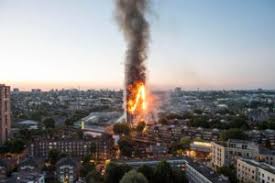

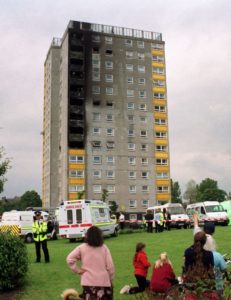
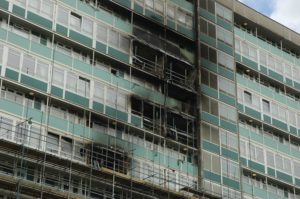
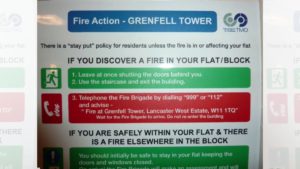
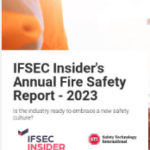
I haven’t heard any mention of the CDM Coordinator role in this. I would have thought the CDM C would have been aware of the change of cladding material to a flammable material and would have raised concerns with the designers. It would be interesting to read what the HAndS File says about fire safety compartmentation and fire spread prevention.
I find as a H&S professional the whole situation sad. The ‘world’ is looking for someone to blame, and this is in part understandable. As Ronnie says, where was the CDMC/Designer and their advice – was it just ignored to save money? What did the Fire Risk Assessment say, and have actions been ignored – who chose to ignore – i’m sure it isn’t number 10 yet they are getting the slating!! Why didn’t the alarm sound? I must say I NEVER advise any of my clients who are in flats to ‘stay put’ even if the fire office has… Read more »
I agree Looby, I lived in a tower block for 20 years, and no way was I ever going to stay put. I might have hung around once I reached the stair landing if there was no sign of any smoke, but inside my flat, never. how many lives were saved in the second World Trade Tower, because a British trained safety adviser countermanded instructions to stay put on the upper floor. Even now the advice is being repeated, BUT, with the reservation expressed, “as long as the integrity of the fire stopping and separation is intact.” I don’t think… Read more »
I agree with Ronnie in that there should be some information in respect of CDM. However all the duty holders when the refurbishment took place should be held to account. I truly feel sorry for everyone involved but someone, probably many people must have considered all of the risks here.
I would also consider the lessons of the Summerland fire to be relevant. The Summerland fire disaster occurred on 2nd August 1973 in Douglas, Isle of Man; fifty people died in the inferno. The fire was started by three boys who were smoking in a disused kiosk. The kiosk collapsed against the wall of the Summerland leisure centre and the fire spread rapidly throughout Summerland. A public inquiry identified that the main cause was the use of highly flammable materials (Galbestos, Decalin & Oroglass) for the external and internal walls; these materials did not comply with the building regulations. No… Read more »
Hi Paul, thanks for this information. I will add this to the article.
I echo Ronnie’s comments where was the CDM Regs in all this? I don’t however believe the CDM-C is the real problem here, because as a former CDM-C I know how you were fobbed off by many a client when you asked about certain materials. The fire element in a Health & Safety File and the Fire consultant would provide the documents and I bet you a pound to a pinch of salt that those materials were fire rated. As a government project why didn’t the so called BREEAM consultant pick up on the materials ? I know it is… Read more »
How many Regulations could be involved in this investigation?